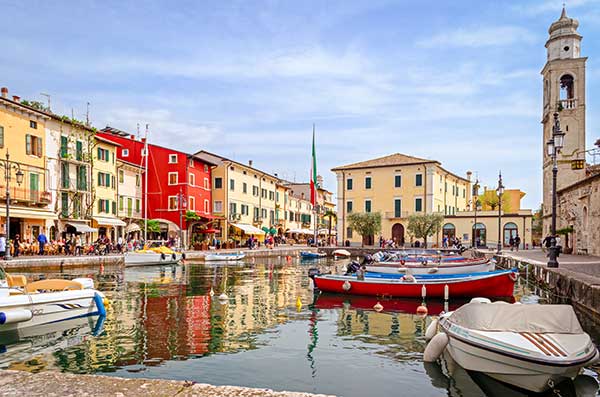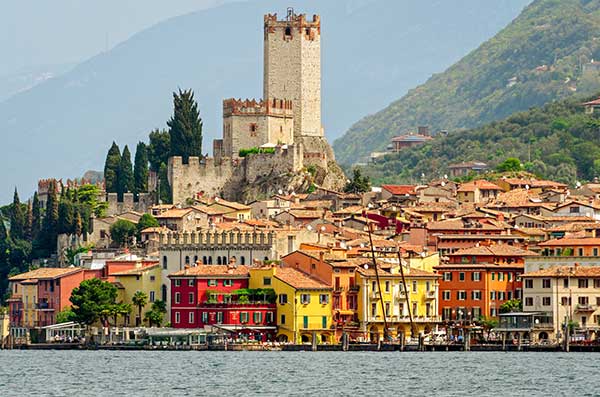Lake Garda
Lake Garda is one of the main tourist destinations in Italy. From Verona you can reach it in half an hour drive.
Contacts
Ask the tour guides of Lake Garda to organize an exclusive guided tour for you. Half-day or full-day itineraries: panoramic bus tours, excursions on foot and by boat, wine and olive oil tastings.
Lake Garda is the largest lake in Italy, between the provinces of Verona in the east, Lombardy in the west and Trentino in the north. Lake Garda with its extension from north to south, its large surface, its natural environments, is a series of worlds and universes to be discovered. Lake Garda is a destination for sportsmen and women who come from all over the world to practice windsurfing, sailing, mountain biking, golf, paragliding, hiking and trekking. Lovers of wine and gastronomy can find on the surrounding hills and in its immediate vicinity, famous wines such as Bardolino, Val d'Adige, Lugana, Custoza and the delicate extra virgin olive oil Garda DOP. Numerous medieval castles (Sirmione, Lazise, Valeggio, Malcesine, Torri), Romanesque churches (San Severo, Santa Maria di Cisano), Renaissance villas (Punta San Vigilio, Villa Cavazza), Roman remains (Grotte di Catullo, Villa di Desenzano) and prehistoric sites can become the destination of interesting guided historical-artistic itineraries. On the east coast, water parks, amusement parks, zoos, restaurants, pizzerias, discos and trendy clubs can satisfy those who, after so much nature and culture are looking for fun and entertainment.
Destinations and Itineraries
Below you will find some suggestions to guide you in choosing destinations within Lake Garda and the themes on which to focus your guided tour.
Sirmione
Sirmione is undoubtedly one of the most famous and fascinating destinations of Lake Garda. It is a thin peninsula that extends from the south coast to the north. A place so fascinating that it has always been inspiration for poets and artists, from the Roman poet Catullus, who was originally from here, to opera singer Maria Callas, who spent her Summer holidays there.
Catullus' Grotto
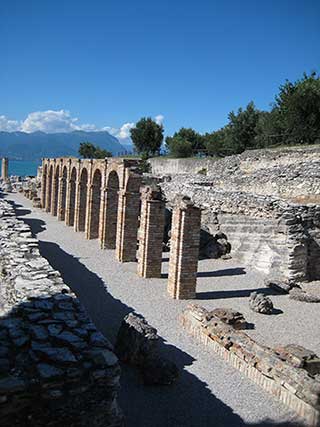 The
northern end of this strip of land has been inhabited since Roman
times. The remains of an imposing rustic villa, the so-called "Grotte
di Catullo", are the most important testimony of this age.
It is not a real cave, but it looked so in the
middles age, when bushes and trees grew wild among the old
structures.
The
northern end of this strip of land has been inhabited since Roman
times. The remains of an imposing rustic villa, the so-called "Grotte
di Catullo", are the most important testimony of this age.
It is not a real cave, but it looked so in the
middles age, when bushes and trees grew wild among the old
structures.
The great Latin poet was actually from Sirmione (Sirmio),
and although there is no certainty that the remains belong to his
family's home, some clues make it at least very likely. The Grotto
of Catullus extends over more than two hectares (4 acres) of land
and are the largest archaeological area in northern Italy.
Even if in a very poor state of conservation, it is still possible
to distinguish the remains of a long cryptoporticus
(photo), of the thermal area with the various tanks equipped with
cavities for heating (hypocausto), an immense cistern for
collecting water and the imposing substructures that supported a
panoramic terrace in front of the lake. What can still be admired
today on this site, together with the enchanting panoramic
position in front of the lake, make it an essential stop on any
itinerary on Lake Garda.
Scala Family Castle
In the medieval village of Sirmione you can visit, also internally, the ancient castle of the Scala era (1300), with its keep from which you can enjoy an enchanting 360° view of the peninsula and the lake, the fortified dock, the crenellated walls and drawbridges.
Hot Springs
Sirmione is also famous as a spa. A hot sulphurous water source flows from the bottom of the lake and, channelled, is distributed in the various wellness centers and hotels in the country. Its curative properties for respiratory disorders are widely documented.
Boat Tours
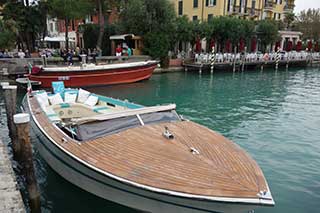 Sirmione
is also the ideal place to enjoy a trip by boat. For example, a
simple and easy circumnavigation of the peninsula to admire from a
different point of view the lake and the imposing remains of the
Catullus' Grotto' archaeological area, the Scala family castle,
Maria Callas' villa.
Sirmione
is also the ideal place to enjoy a trip by boat. For example, a
simple and easy circumnavigation of the peninsula to admire from a
different point of view the lake and the imposing remains of the
Catullus' Grotto' archaeological area, the Scala family castle,
Maria Callas' villa.
Or you can depart from Sirmione to go by water to other places on
Lake Garda such as Lazise, Bardolino, or Salò and Lake Garda
Island. Excursions are possible in small and agile private
motorboats or in comfortable vessels suitable for transporting
organized groups, which can also be rented for parties and events.
Peschiera, Valeggio sul Mincio, Borghetto
Peschiera is located in the south-eastern corner of Lake Garda. Of Roman origin (Arilica), it became an important strategic centre in the Scaligeri and above all in the Venetian period (1500) when the polygonal fortress was built on the project of the Renaissance architect Michele Sanmicheli, and whose mighty walls and ramparts overlooking the water still surround the town today. The importance of Peschiera resided in the fact that it was at the mouth of the Mincio, the only outfall of Lake Garda, always a natural boundary line between regional and national states. The whole territory of lower Garda, including Peschiera, was in fact affected by the bloody Risorgimento conflicts that ended in 1866 with the annexation of the Veneto to the Kingdom of Italy.Valeggio sul Mincio, the Castle, Tortellini
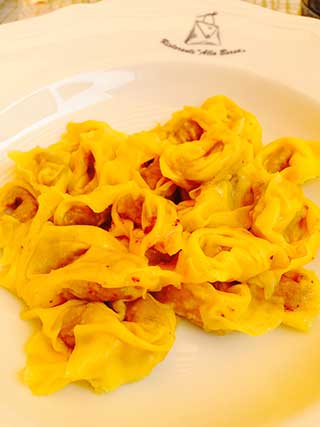 Following
the course of the river Mincio, you reach
Valeggio. A pleasant town characterized by the ruins of a castle
dating back to the Scala family period, which
overlooked the river and the plain south of the morainic hills of
Lake Garda. Legend has it that the ghost of Andriolo da
Parma, captain of the castle unjustly condemned for
treason, still wanders the castle on full moon nights in search of
his broken sword. Part of the defensive system of Valeggio was
also the imposing Visconti bridge-dam that in the
plans of Gian Galeazzo Visconti was to block the course of the
Mincio. Valeggio is also famous for its most typical
dish: tortellini. A legend links the origin of this
refined preparation to a pledge of love between a medieval knight
and a water nymph: a knotted silk handkerchief
that recalls the shape of the tortellini and the almost transparent
fineness of the dough typical of the tortellini of
Valeggio. There are many pasta factories and restaurants where you
can buy and enjoy them.
Following
the course of the river Mincio, you reach
Valeggio. A pleasant town characterized by the ruins of a castle
dating back to the Scala family period, which
overlooked the river and the plain south of the morainic hills of
Lake Garda. Legend has it that the ghost of Andriolo da
Parma, captain of the castle unjustly condemned for
treason, still wanders the castle on full moon nights in search of
his broken sword. Part of the defensive system of Valeggio was
also the imposing Visconti bridge-dam that in the
plans of Gian Galeazzo Visconti was to block the course of the
Mincio. Valeggio is also famous for its most typical
dish: tortellini. A legend links the origin of this
refined preparation to a pledge of love between a medieval knight
and a water nymph: a knotted silk handkerchief
that recalls the shape of the tortellini and the almost transparent
fineness of the dough typical of the tortellini of
Valeggio. There are many pasta factories and restaurants where you
can buy and enjoy them.
Borghetto
A short distance from Valeggio is Borghetto, one of the most picturesque villages in Italy. The village was literally built on the river Mincio, consisting of a set of water mills that today, while maintaining their characteristics and large wheels, have been transformed into bars, restaurants, small hotels, shops. The colours, the light and shade, the reflections of the lush green of the banks of the Mincio and the ever-changing and moving surface of the water make Borghetto a place of rare charm.
Lazise, Bardolino, Punta San Vigilio, Albisano
The east coast of lake Garda, the one closest to Verona, is characterized by a string of ancient fishing villages, which later became Scala family garrisons in the Middle Ages and today renowned tourist destinations.
Lazise
The oldest borgo (medieval state city) in Italy, in 983 it received from the emperor Ottone, the right to build walls and collect taxes. In 1300 the Scala family built a castle and high crenellated walls that still characterize this pleasant village. In the center of Lazise there is the small harbor that creeps into the main square (photo above), characteristic of many Garda settlements, as well as the winding alleys flanked by stone houses that today house ice cream shops, restaurants and boutiques. From Lazise you can take the pedestrian lakefront that connects, for several kilometers, the various towns overlooking the east coast of the lake, or take a boat of the Garda Navigation line to reach various destinations.
Bardolino
Not unlike Lazise is also Bardolino, with the remains of the Scala family fortifications, and the parish church of San Severo, an austere and charming Romanesque rural church. Bardolino gives its name to the wine that is produced on the hills that stretch along the east coast of Lake Garda. There are many wineries where you can stop for a taste of wines and various products.
Punta San Vigilio
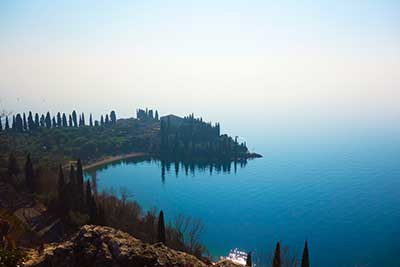 It
is a promontory on the lake owned by the noble family Guarienti.
In the 16th century a Venetian villa was built
here, the work of the Veronese Renaissance architect
Michele Sanmicheli. Around the villa were built the
dwellings of the workers who were responsible for the possessions
of the Guarienti, a private port for connections
via the lake before the coastal roads were built, a lemon
greenhouse. Following a careful restoration, the old buildings
have now been transformed into a hotel, the small dock is used for
pleasure boats and in a bar restaurant you can enjoy a
drink watching the calm movement of the waters of Lake Garda.
Strolling along the cobblestones of Punta San Vigilio, the
cypress-lined avenues and the lake promenade is a relaxing and
evocative experience that will take you back in time.
It
is a promontory on the lake owned by the noble family Guarienti.
In the 16th century a Venetian villa was built
here, the work of the Veronese Renaissance architect
Michele Sanmicheli. Around the villa were built the
dwellings of the workers who were responsible for the possessions
of the Guarienti, a private port for connections
via the lake before the coastal roads were built, a lemon
greenhouse. Following a careful restoration, the old buildings
have now been transformed into a hotel, the small dock is used for
pleasure boats and in a bar restaurant you can enjoy a
drink watching the calm movement of the waters of Lake Garda.
Strolling along the cobblestones of Punta San Vigilio, the
cypress-lined avenues and the lake promenade is a relaxing and
evocative experience that will take you back in time.
Albisano
More than a village, a small group of houses gathered around a
church on the slopes of Mount Baldo ending in the waters of Lake
Garda. The tree-lined terrace in front of the parish church of San
Martino offers one of the most extraordinary panoramic
views of Lake Garda.
Malcesine and the Northern Side of Lake Garda
Proceeding northwards, Lake Garda changes its shape and landscape, increasingly taking on the appearance of a lake of glacial origin, narrowed in a steep mountain gorge. The gateway to the upper Garda is Malcesine, the last town belonging to Verona province, perched on a promontory overlooking the lake topped by the charming Scala castle which is open to the public. The picturesque alleys of the village are an ideal stop for a walk, a coffee or an aperitif in one of the many bars and cafes.
Torbole e il Windsurf
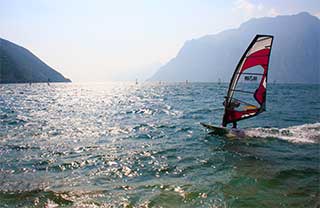 The
top part of Lake Garda, in the Trentino region, is a paradise for
sailing sports. First of all thanks to the winds, the Peler
and the Ora, tense and regular, which
blow from north to south in the first part of the day and from
south to north from early afternoon. And then thanks to the
ban on motor navigation that characterizes this area of
the lake, making it a true paradise for windsurfing,
kitesurfing, sailing boats. On windy Summer days it is
not unusual to see the rippling surface of the water covered with
hundreds of colorful sails that chase every breath, glide, chase
each other in races and regattas. Torbole is the most important
center of the area, famous all over the world among sailing sports
fans who in the evening meet in the bars and restaurants to tell
each other about their exploits of the day.
The
top part of Lake Garda, in the Trentino region, is a paradise for
sailing sports. First of all thanks to the winds, the Peler
and the Ora, tense and regular, which
blow from north to south in the first part of the day and from
south to north from early afternoon. And then thanks to the
ban on motor navigation that characterizes this area of
the lake, making it a true paradise for windsurfing,
kitesurfing, sailing boats. On windy Summer days it is
not unusual to see the rippling surface of the water covered with
hundreds of colorful sails that chase every breath, glide, chase
each other in races and regattas. Torbole is the most important
center of the area, famous all over the world among sailing sports
fans who in the evening meet in the bars and restaurants to tell
each other about their exploits of the day.
The Wine: Bardolino, Lugana, Custoza
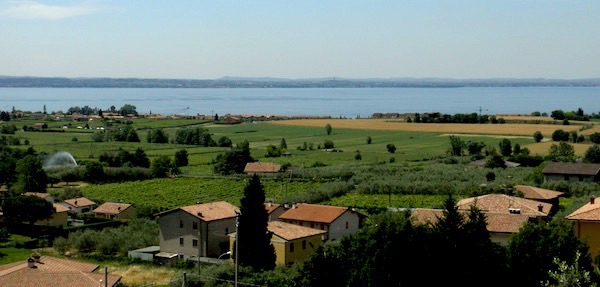
Lake Garda is also an area of wine production. Many of the wineries around the lake offer the possibility of guided tours with tasting, that can be combined with tasty snacks made with local products.
Bardolino
Among the wines of the lake it is perhaps the best known. It takes its name from a village of the on the east coast of Lake Garda. The hills along the lake and the eastern valleys are covered with vineyards of grapes Corvina, Rondinella, Molinara that make up the blend of Bardolino wine. It is a light, fresh, fruity red wine. It should be drunk rather young, possibly slightly chilled, and can be paired with the whole meal, pizza, pastas with not too elaborate sauces, white meats, fresh or slightly aged cheeses. Famous in the rosé version, the Bardolino Chiareto. Among the wineries that offer the best tasting experiences: Guerrieri Rizzardi, Fratelli Zeni, Villa Calicantus, Poggi.
Lugana
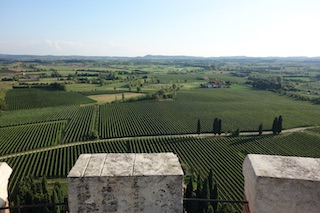 It
is one of the smallest DOC (Denomination of Origin Controlled)
wine area in Italy, south of Lake Garda, between Peschiera and
Sirmione, between the shores of the lake and the morainic
hills. An area that, as a wine-growing area, is unusually
flat and rich in clay, where the Turbiana
vine varietal is grown, which gives a white wine of extraordinary
structure, minerality and longevity: the Lugana DOC. In
recent years it has enjoyed extraordinary success which, since
production is very limited, has put pressure on prices and
availability. Among the wineries to visit in the area: Pilandro,
Ca' Lojera, Cascina Maddalena.
It
is one of the smallest DOC (Denomination of Origin Controlled)
wine area in Italy, south of Lake Garda, between Peschiera and
Sirmione, between the shores of the lake and the morainic
hills. An area that, as a wine-growing area, is unusually
flat and rich in clay, where the Turbiana
vine varietal is grown, which gives a white wine of extraordinary
structure, minerality and longevity: the Lugana DOC. In
recent years it has enjoyed extraordinary success which, since
production is very limited, has put pressure on prices and
availability. Among the wineries to visit in the area: Pilandro,
Ca' Lojera, Cascina Maddalena.
Custoza
The territory south of Lake Garda is characterized by the morainic hills formed by the accumulation of debris dragged by the glacier that gave life to the lake in the succession of glaciations. In the Risorgimento (Italian independentist movement ) it became the field of violent battles between the Italian and Hapsburg armies: Custoza, San Martino, Solferino, remembered by important memorials. Today these hills are covered with the vineyards of Custoza DOC wine, made with a blend of various native, national and international vines. The result is a fresh wine, very fragrant, floral and fruity, particularly pleasant and versatile both as an aperitif and in combination with fish dishes. Among the wineries to visit: Piona, Tamburino Sardo, Monte del Frà. There are many farmhouses on the morainic hills where you can try it in combination with tasty local dishes.
Salò, il Vittoriale, the Garda Island

On the western shore of Lake Garda Salò is one of the most important centers. Its name is linked to the dramatic events of the Italian Civil War between 1943 and 1945, although today it is a quiet town in the middle of a large lake gulf. According to legend, it was the birthplace of the inventor of the violin: Gasparo da Salò.
Garda Island
From Salò it is possible to take the boat shuttle service to reach the suggestive Garda Island, the biggest of the lake. The island is now privately owned, and houses a park with exotic essences and a sumptuous nineteenth-century villa in Gothic-Venetian style. Visits to both the park and the villa are possible.
Il Vittoriale degli Italiani
The last residence of Gabriele D'Annunzio, a poet and writer,
considered one of the father of modern Italian language. The villa
with park was transformed by D'Annunzio himself into a museum of
his extraordinary life with the relics of his achievements and the
celebration of his artistic works, finally donated to the Italians
and still open to the public. In the large park surrounding the
complex there is the ship Re di Puglia, set in the hill, and the
torpedo motorboat MAS with which D'Annunzio performed the Beffa di
Buccari, a very courageous naval incursion during I World War, and
then again the personal theater of the poet and the large
mausoleum where he is buried along with some legionnaires who
participated in the occupation of Fiume. Inside the villa there
the cars that D'Annunzio drove, and the airplane with which he
flew over Vienna during the war as well as another infinity of
memorabilia.
Desenzano and the Roman Villa
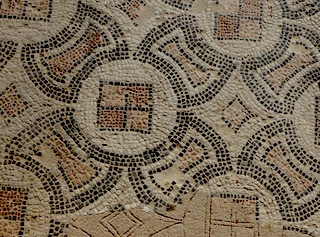 On
the south-west corner of Lake Garda, along the Milan-Venice
motorway and railway line, Desenzano is one of the major towns on
the lake, with a long and pleasant waterfront path, alleys and
squares full of shops and clubs. In the center of Desenzano there
is also one of the most important archaeological sites in northern
Italy, with the remains of a large Roman villa and its extraordinary
mosaics still perfectly preserved. The Roman villa in
Desenzano is an ideal destination, especially for schoolchildren
traveling for education to deepen their study of Roman history.
On
the south-west corner of Lake Garda, along the Milan-Venice
motorway and railway line, Desenzano is one of the major towns on
the lake, with a long and pleasant waterfront path, alleys and
squares full of shops and clubs. In the center of Desenzano there
is also one of the most important archaeological sites in northern
Italy, with the remains of a large Roman villa and its extraordinary
mosaics still perfectly preserved. The Roman villa in
Desenzano is an ideal destination, especially for schoolchildren
traveling for education to deepen their study of Roman history.
Further information and details on
guided tours on Lake Garda:

